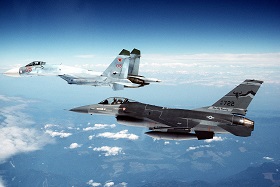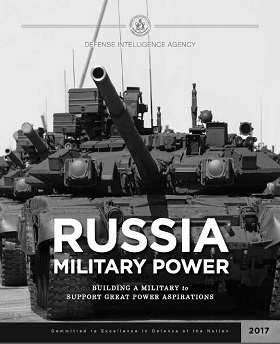Trading the Iron Curtain for Iron Shackles: Russian and the U.S. National Security Strategies
In
Login if you are already registered
(votes: 14, rating: 5) |
(14 votes) |
Princeton University
The report, “Russia Military Power: Building a Military to Support Great Power Aspirations,” was produced by the United States’ Defense Intelligence Agency (DIA) in 2016 in order to provide a politically neutral perspective on the Russian Federation’s militaristic goals, and how these interests are being integrated into the strategy of the state. It should be noted that the “neutral” political stance of the agency merely implies that it is formally not associated with either of the major political parties in the United States; further, it should not be assumed that it views the policies and choices made by other states are being viewed through a completely neutral lens. The administration in place at a given moment asks intelligence sources such as the DIA to gather information on potential threats in order for the government to proactively shape policies to combat future threats to national and international security. The DIA itself is a reputable organization, providing in-depth and comprehensive analyses as accurately as possible. However, it is impossible for any extension of the executive to truly do so without subtle biases. The resulting product illustrates how the grand strategy of the Russian Federation is interpreted in the eyes of the American government. Though the goals, taken at face value, diverge from those of the United States drastically, the underlying themes and desires to shape the world order are strikingly similar.
A Review of the Defense Intelligence Agency’s Report on Russian Military Power
The seemingly contradictory agendas of the United States and the Russian Federation since the end of the Cold War have presented significant threats to the preservation of international peace and order. The United States, aiming to maintain its power by cementing a unipolar order into place, is increasingly viewed by the international community as a force that has overstepped its bounds in order to maintain militaristic and sociopolitical supremacy. Consequently, other recognized powers have increasingly felt the urge to challenge this hegemony by expanding their national security strategies with techniques that strive to make their states’ presence known in the international arena. The Russian Federation has done exactly this. After the end of the Cold War, the vision of Russian grand strategy needed to change drastically and holistically in order for the state to maintain its position of preeminence in international affairs. Not content with accepting the unipolar system established by the United States, the Russian Federation quickly acted to modify its military capabilities to fit in with a new national security agenda. As it became increasingly clear that the Russian state was not going to fall with the Iron Curtain, the United States began to claim that the Russian strategy was aggressive, and not in concurrence with international law and the set of universalistic values it had worked to weave into the fabric of a newly, and increasingly, globalized world.
The report, “Russia Military Power: Building a Military to Support Great Power Aspirations,” was produced by the United States’ Defense Intelligence Agency (DIA) in 2016 in order to provide a politically neutral perspective on the Russian Federation’s militaristic goals, and how these interests are being integrated into the strategy of the state. It should be noted that the “neutral” political stance of the agency merely implies that it is formally not associated with either of the major political parties in the United States; further, it should not be assumed that it views the policies and choices made by other states are being viewed through a completely neutral lens. The administration in place at a given moment asks intelligence sources such as the DIA to gather information on potential threats in order for the government to proactively shape policies to combat future threats to national and international security. The DIA itself is a reputable organization, providing in-depth and comprehensive analyses as accurately as possible. However, it is impossible for any extension of the executive to truly do so without subtle biases. The resulting product illustrates how the grand strategy of the Russian Federation is interpreted in the eyes of the American government. Though the goals, taken at face value, diverge from those of the United States drastically, the underlying themes and desires to shape the world order are strikingly similar.
Not content with accepting the unipolar system established by the United States, the Russian Federation quickly acted to modify its military capabilities to fit in with a new national security agenda.
The end of the Cold War brought about a period of dramatic change in the Russian military and, subsequently, its strategy. The development of military technologies was a primary sector of innovation and economic stimulation for the Soviet Union; however, the conflicts that occurred throughout the end of the twentieth century into the twenty-first century, after the state had transitioned to be the Russian Federation, mandated that the military be restructured in order to diverge away from a militarized state. The economic turmoil that ensued throughout the 1990s resulted in a state that could not sufficiently fund its armed forces as they were. This prompted the various defense ministers appointed between 1992 and 2008 to push for significant military reforms that would pull the military out of the Soviet era. However, the report notes that there were no legitimate, sufficient plans put into place to follow through on the reforms. The state recognized that it was lagging behind the other prominent countries of the world, and formulated a new strategy for reformation through the New Look program. This program is accurately labeled by the DIA as a potential threat to American power. Through this plan, the Russian military altered itself to be adept to responding to modern conflicts with proportional responses, in contrast with the previous structure that relied on dated nuclear deterrents. It is through this program that the DIA believes Moscow may project its interests to become a predominant force in an increasingly multipolar system of power. This view is a stark, sobering projection provided by the agency, without attempting to undermine the legitimacy of this plan. There is a recognition that although modernizations to the Russian military were slow after the initial collapse of the Soviet Union, that the state is quickly gaining traction in the modern sphere. The focus of this section was not on the American response to these changes, but instead chooses to objectively present the plan without discussing what the United States believes it should or could do in response. Such objectivity is rare in the discussion of strategy amongst superpowers. Yet, in the proceeding sections, the report does not escape the bounds of bias and subjectivity.

Russia and NATO: A Paradoxical Crisis
In the accompanying discussion of Russia’s perception of threat within the international sphere, it is noted that the Kremlin believes that the international order is balanced in a way that gives American power more weight than any other state can realistically hope to achieve. Objectively, this assessment provided by the Russian Federation is undoubtedly accurate, with the United States remaining unparalleled in influence and power into the twenty-first century. There is no discussion of the validity of this belief, or how it is shared by a vast majority of the international community. Instead, the report transitions to focus primarily on the broad national security goals as provided by the Russian Federation’s National Security Strategy, published in 2015. The report delineates a course of action that outwardly appears as rational and calculated. The Russian Federation, according to this report, strives to promote a multipolar international order, respect the sovereign rights of states, promote the power of the United Nations and other international and collectivized institutions, and work to prevent “bloc rule” of the international sphere by curtailing the influence of large alliance blocs such as NATO. However, the report goes on to argue that the recent militaristic action taken by the Russian Federation actually exemplifies that the state has a permeating and prominent sense of insecurity in regards to the United States, and is paranoid in its perception of how American actions serve to detriment Russian interests domestically and internationally. Though the report does outline the various concerns that it believes Russia has in regards to U.S. action, there is little accompanying commentary to reconcile the Russian and American viewpoints regarding each state’s seemingly contradictory national security goals and strategies. A subtle form of bias may be found in the fact that the report spends a disproportionate amount of time discussing the Russian policies and attitudes towards the United States and NATO, while leaving other prominent portions of Russia’s national security strategy, such as the threat perceptions present in regards to China and the Islamic militant state, largely not discussed.
Though this report offers extensive information on the expected and completed military reforms put into place by the Russian Federation, there is very little mentioned about its actual strategy in promoting and preserving national security.
The report does include a section that discusses the strategy released by President Putin and his administration in 2015, though not in sufficient detail to fully understand the goals and policy objectives that the Russian Federation wishes to push forth. Instead, the report simply lists the broad policy goals that the Kremlin provides in its 2015 national security strategy report. Further, the focus that the DIA report puts on the actual strategy points provided by the Kremlin is American-centric: there is very little time spent discussing any of the points in detail other than the section that states that NATO and the United States are pursuing action that serves to intentionally undermine the authority of the Kremlin, and is formally recognized as a threat to Russian national security. Additionally, the report chooses to focus on the lack of plurality and true civil liberty within the Russian state. Though these claims may be substantiated within the frame of reference provided by the West, they do little to actually add to the discussion on Russia’s military capabilities and expected strategies as the twenty-first century progresses. This technique might be utilized in order to redirect the discussion away from a cut and dry comparison between the strategies of the United States and Russia, which this review will discuss in a later section.
The final section of the report discusses the military doctrine and strategy of the Russian Federation. Not surprisingly, the tone utilized in the discussion of the development of Russia’s defense systems is written in a tone of reproach, ironically illustrating actions as aggressive, even though the United States has adopted similar measures in order to project its own military might on a global scale. This discrepancy exemplified the apparent double standard that is projected by the United States in terms of power capabilities. If it partakes in such armament, it is promoting the security of the world. If another state follows suit, then the action immediately is vilified by the American government as an aggressive display of malicious intent. Realpolitik would serve as a justification of this opinion; further, a purely realist ideology would not necessitate the accompanying explanation for expressing power. The claim is already transparent, lacking in legitimate substance. Of course, this is not to say that the United States is not strategically savvy for doing just that. Creating the illusion of a legitimate justification for the use of power and force maintains the image that the United States wishes to project into the world. They are strategically inclined to perpetuate their image as the world’s benevolent policeman; however, this does not mean that other states are doing anything different than it is, even if the carefully constructed pretenses are not in place.
Further within this section is the debate on the qualifications necessary for a sufficient “deterrent.” Strategic deterrence has been a staple in the military strategy of the Russian Federation since the dissolution of the Soviet Union. In this sense, deterrence does not simply refer to the presence of a formidable arsenal in order to dissuade rogue powers from engaging in a military strike. Rather, this strategy of deterrence involves a coordinated effort of projecting economic, ethical, moral, sociopolitical, and militaristic capabilities in order to stabilize the domestic and international environment while also preventing serious aggression from occurring [1]. Another staple of the Russian strategy that is described is the highly centralized chain of command within the decision-making body, which the state views as an effective way of preserving order and delivering decisive action when necessary. The report does little to criticize this method of decision-making, doing away with the bias that may have otherwise taken focus from an informative debriefing of the Russian Federation’s main defense hierarchy. Additionally, there is a discussion concerning the core military capabilities possessed by the current Russian state. The report takes care to mention Russian involvement in multilateral arms reduction treaties, somewhat contradicting the accusatory tone that followed the statement criticizing Russia’s refusal to adhere to “no-first-strike” agreements earlier in the report. The Russia-U.S. “New START” (New Strategic Arms Reduction Treaty) signed into agreement on 8 April 2010 set definitive limits on the amount of strategic warheads that was acceptable [2]. This roughly equalizing force serves to neutralize paranoia where possible. The rest of this section spends a considerable amount of space outlining the misconduct that Russia has performed in regards to chemical weaponry. However, this is not a sign of bias, but is a more comprehensive take on all weapons systems in question in the formation of relations between the United States and Russia. The discussion of alleged wrongdoing outwardly appears to serve one side of an argument; however, it is important to distinguish American bias from the objective presentation of facts.
The idea that the Russian Federation will engage in opportunism disguised as benevolence is perfectly rational. The United States already engages in this action, why would any other formidable power not follow suit?
Perhaps the most biased opinion expressed in the report is that the Russian Federation engages in the spreading of propaganda to influence public opinion and dissuade opposition. While the government may be utilizing resources to meet these ends, the way that the report frames such action equates it to Soviet-era propaganda. This “re-Sovietizes” the image of the Russian Federation, making it easy for the reader to automatically condemn the action. While one may objectively maintain that censorship campaigns and governmental efforts to block information to the public are objectionable at best, the way that the information is presented in the report becomes of primary importance. Suddenly, the problem appears to be one of the Cold War era, rather than one that involves modern practices with less severe implications. The report offers several major themes that it purports are central to Russian propaganda, many of which make the United States out to be a villain that cannot respect the international order. Each state can argue on and on over which views are correct; however, by only offering this analysis of the information campaign, the report effectively galvanizes the formation of the opinion that it is an effective solution to the problem of the spreading of false information is villainizing the Russian Federation as a whole. The subsequent turn to debate glasnost policies against the current approaches the Russian government has taken to control information loses some of its weight simply because the reader cannot forget the extensive discussion of the propaganda techniques, and how they are interpreted by the United States.
Though this report offers extensive information on the expected and completed military reforms put into place by the Russian Federation, there is very little mentioned about its actual strategy in promoting and preserving national security. In order to fully integrate the report’s findings into a well-rounded opinion as to what the future of Russia-U.S. relations hold, it is necessary to analyze each state’s strategy in relation to the points assessed in the DIA report. The two strategies, though aiming to promote very different ideals and interests, have a definitive commonality: the aim to preserve power. The most recent national security strategy released by the executive branch of the United States is that of the Obama Administration in 2015. As the last strategy produced by the Russian Federation was given in the same year, an analysis of the documents will provide the most recent insight into the formalized strategies of the two states. This statement is qualified, however, by the knowledge that the new Trump Administration in the United States has yet to release its new national security strategy in accordance with President Trump’s national security views and goals.

Russia and the West, Trapped by Their Own Double Standards
As has been mentioned, both the United States and the Russian Federation seek to project their power through displays of their military power in foreign conflicts. Each strategy report asserts that the respective states would come to the need of other states when necessary, and that the use of force to preserve international peace and stability was justified. Though seemingly beneficial for the rest of the states in the world, many of which rely on larger and more powerful states for their security and protection, this strategy allows each state to display power and advance its own interests. The United States is not the only country limited to such opportunism. This view resonates with the evidence and themes carried on throughout the DIA report. The idea that the Russian Federation will engage in opportunism disguised as benevolence is perfectly rational. The United States already engages in this action, why would any other formidable power not follow suit? Additionally, both of the states in question describe a desire and duty to project a certain set of values over the world. Though the qualities of the ideologies differ considerably, the goal itself remains the same. Each strategy offers the obligatory pledge to adhere to international law, and do what is possible to strengthen the legitimacy and potency of international bodies such as the United Nations to act as a mediator within international conflict. However, both the United States and the Russian Federation have engaged in action that exemplifies that power and opportunism will almost always outweigh allegiance to multilateral institutions. As a state that has more to gain from a transition to a multipolar world order, the Russian Federation stresses the need for multilateral cooperation more than the United States does in its own strategy report. However, there is no bias required to take note that the Russian Federation only truly supports multipolarity only insofar as it is a means for it to reach a position of supremacy among the new order of states. In this way, its ideology mirrors that of the United States: employ the strategy necessary to get ahead while disguising it so it is more palatable to the rest of the international community. Additionally, each strategy briefly mentions that it is open to improving relations with the other. However, many of these claims are set in the precondition that the other drastically changes some element of foreign policy, effectively nullifying this seemingly diplomatic provision. An analysis of the two strategies leads to one, primary conclusion: the plans of two rival superpowers are not actually all that different from each other. Each embodies the most basic tenets of realism and opportunism aimed at preserving and projecting power well into the future. Though the values and interests may vary, the means of serving each follow the same basic pattern of action. The DIA report lacks this realization. Further, it is extremely difficult to draw conclusive opinions for future policy from reports that do not include an objective comparison to how a rival’s strategy mirrors or differs from one’s own.
The rise in militaristic capabilities, as analyzed in the DIA report, is an expected response to the continued preeminence of the United States in international politics. The United States’ own strategy would dictate the same action if the roles were reversed.
The future of Russia-U.S. relations, and, therefore, the presence or absence subsequent action to enhance militaristic capabilities on either side, relies heavily on the realization that American strategy and Russian strategy are not all that different. Rather, the two rely on many of the same tactics to achieve quite different end goals. The rise in militaristic capabilities, as analyzed in the DIA report, is an expected response to the continued preeminence of the United States in international politics. The United States’ own strategy would dictate the same action if the roles were reversed. Therefore, until one side is able to see the issues inherent in two superpowers attempting to promote their own individual interests while using the same pattern of strategy, and alter future policy accordingly, the chances of pacifying animosity and distrust between the United States and the Russian Federation are low. Not including such analysis in intelligence reports such as the one discussed only perpetuates this situation.
However, it is important to note that the grand strategy of the United States should not necessarily come under attack as a result of this report. Clearly, it is nearly impossible to fully escape biases while gathering information on behalf of the state. Certain opinions and interpretations will almost always be present that seem to skew information. Still, this does not mean that the facts presented by the report are inaccurate or that they should not be taken seriously. Subsequently, the critiques offered in this review concerning the DIA report should not be taken as a suggestion that American grand strategy is illegitimate or in opposition to the entirety of the international community. As the current hegemonic power, it is expected that the United States will act in ways that display its exceptionalist status among the international community, and doing so may be argued to be a vital step in the preservation of its national security and maintenance of international order. Though this is often construed by rival states as a violation of international diplomatic norms, critics would be hard-pressed to find any state that would not be doing the exact same things that the United States has to preserve and project power on the same scale. American grand strategy itself, as realist ideology would dictate, does much to service the interests of the United States. Additionally, though, it must be recognized that its actions are not wholly self-serving, but also serve to bolster the viability of its allies and partners. However, where these actions cause friction with states that are considered in competition with the United States is where there is room for an evolution of thought and strategy.
References
"National Security Strategy 2015." National Security Strategy Archive. February 09, 2015. Accessed
July 7, 2017. http://nssarchive.us/national-security-strategy-2015/.
"2015 National Security Strategy." December 31, 2015. Accessed July 7, 2017. http://www.ieee.es/Galerias/fichero/OtrasPublicaciones/Internacional/2016/Russian-National-Security-Strategy-31Dec2015.pdf.
The United States of America. The Defense Intelligence Agency. Russia Military Power: Building a Military to Support Great Power Aspirations. The Defense Intelligence Agency (under the U.S. Department of Defense).
1. The United States of America. The Defense Intelligence Agency. Russia Military Power: Building a Military to Support Great Power Aspirations. The Defense Intelligence Agency (under the U.S. Department of Defense), 23.
2. The The United States of America. The Defense Intelligence Agency. Russia Military Power: Building a Military to Support Great Power Aspirations. The Defense Intelligence Agency (under the U.S. Department of Defense), 31.
(votes: 14, rating: 5) |
(14 votes) |
RD Interview
A Roadmap for U.S.-Russia RelationsExecutive Summary of the CSIS and RIAC Report
The US Submarine Force and the Growing Russia-US AnimosityAn enemy you know is better?
The Armed Forces of Baltic and Eastern European StatesLatvia, Lithuania, Estonia, Moldova, Belarus, Ukraine
Russia and NATO: A Paradoxical CrisisThe biggest threat today is an uncontrolled and rapid arms race that matches or outpaces the political rhetoric






